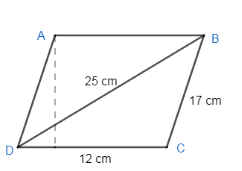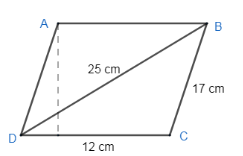
Find the area of a parallelogram given in Figure. Also find the length of the altitude from vertex A on the side DC. (in $c{{m}^{2}}$ )


Answer
589.5k+ views
Hint: To find the area of a parallelogram $ABCD=\text{Area of }\Delta \text{ABD+Area of }\Delta BCD$ . First determine the area of a triangle using Heron's formula $\sqrt{s\left( s-a \right)\left( s-b \right)\left( s-c \right)}$ . Also determine the area of parallelogram by using the formula $Base\times Height$ to find the length of the altitude from vertex A on the side DC.
Complete step-by-step answer:
We know that the diagonal of a parallelogram divides it into two congruent triangles.
So, area of a parallelogram $ABCD=\text{Area of }\Delta \text{ABD+Area of }\Delta BCD$ .
Here, we will find the area of $\Delta BCD$
According to Heron’s formula the area of a triangle with sides a, b, & c is given as –
$\text{Area}=\sqrt{s\left( s-a \right)\left( s-b \right)\left( s-c \right)}$ .
Where,
$s=\dfrac{\left( a+b+c \right)}{2}$ .
Here, we have from the figure –

$a=CD=12cm,\text{ }b=BC=17cm,\text{ c=BD=25cm}\text{.}$
So, we will get the value of s as –
$\begin{align}
& s=\dfrac{\left( 12+17+25 \right)}{2} \\
& =\dfrac{54}{2} \\
& =27 \\
\end{align}$
$\therefore s=27$
Now, we will put the value of a, b, c and s in the formula $\text{Area}=\sqrt{s\left( s-a \right)\left( s-b \right)\left( s-c \right)}$ to find $\Delta BCD$.
$\text{Area}=\sqrt{27\times \left( 27-12 \right)\left( 27-17 \right)\left( 27-25 \right)}$
$\begin{align}
& =\sqrt{27\times 15\times 10\times 2} \\
& =\sqrt{8100} \\
& =90 \\
\end{align}$
$\therefore \text{Area of }\Delta BCD=90c{{m}^{2}}$
Since ABCD is a parallelogram,
$\text{Area of }\Delta BCD\text{=Area of }\Delta ABD$
Now, we will find the area of parallelogram.
Area of a parallelogram $ABCD=\text{Area of }\Delta \text{ABD+Area of }\Delta BCD$ .
$\begin{align}
& ABCD=90+90 \\
& =180c{{m}^{2}} \\
\end{align}$
$\therefore $ Area of a parallelogram $ABCD=180c{{m}^{2}}$
Next we will find the altitude of a parallelogram be h.
Let us consider the altitude of a parallelogram to be ‘h’.
Also, area of a parallelogram \[ABCD=\text{Base}\times \text{Height}\]
We know that the altitude of a parallelogram is also known as Height of a parallelogram.
Therefore,
Height of altitude from vertex A on side CD of the parallelogram $=\dfrac{\text{Area of parallelogram ABCD}}{Base}$ .
\[\begin{align}
& =\dfrac{180}{12} \\
& =15cm \\
\end{align}\]
Hence, the area of a parallelogram for the given figure is $180c{{m}^{2}}$ and the altitude from vertex A on side CD is 15 cm.
Note: We have taken the area of both triangles as the same here, but if a student doesn't know that, they can find it separately and then add them together. The mistake of finding an area of parallelogram as \[17\text{ }cm\text{ }\times \text{ }12\text{ }cm\] should be avoided, it is not correct at all. A parallelogram is a simple quadrilateral with two pairs of parallel sides. The opposite or facing sides of a parallelogram are of equal length and the opposite angles of a parallelogram are of equal measure. Opposite sides of a parallelogram are parallel and so will never intersect.
Complete step-by-step answer:
We know that the diagonal of a parallelogram divides it into two congruent triangles.
So, area of a parallelogram $ABCD=\text{Area of }\Delta \text{ABD+Area of }\Delta BCD$ .
Here, we will find the area of $\Delta BCD$
According to Heron’s formula the area of a triangle with sides a, b, & c is given as –
$\text{Area}=\sqrt{s\left( s-a \right)\left( s-b \right)\left( s-c \right)}$ .
Where,
$s=\dfrac{\left( a+b+c \right)}{2}$ .
Here, we have from the figure –

$a=CD=12cm,\text{ }b=BC=17cm,\text{ c=BD=25cm}\text{.}$
So, we will get the value of s as –
$\begin{align}
& s=\dfrac{\left( 12+17+25 \right)}{2} \\
& =\dfrac{54}{2} \\
& =27 \\
\end{align}$
$\therefore s=27$
Now, we will put the value of a, b, c and s in the formula $\text{Area}=\sqrt{s\left( s-a \right)\left( s-b \right)\left( s-c \right)}$ to find $\Delta BCD$.
$\text{Area}=\sqrt{27\times \left( 27-12 \right)\left( 27-17 \right)\left( 27-25 \right)}$
$\begin{align}
& =\sqrt{27\times 15\times 10\times 2} \\
& =\sqrt{8100} \\
& =90 \\
\end{align}$
$\therefore \text{Area of }\Delta BCD=90c{{m}^{2}}$
Since ABCD is a parallelogram,
$\text{Area of }\Delta BCD\text{=Area of }\Delta ABD$
Now, we will find the area of parallelogram.
Area of a parallelogram $ABCD=\text{Area of }\Delta \text{ABD+Area of }\Delta BCD$ .
$\begin{align}
& ABCD=90+90 \\
& =180c{{m}^{2}} \\
\end{align}$
$\therefore $ Area of a parallelogram $ABCD=180c{{m}^{2}}$
Next we will find the altitude of a parallelogram be h.
Let us consider the altitude of a parallelogram to be ‘h’.
Also, area of a parallelogram \[ABCD=\text{Base}\times \text{Height}\]
We know that the altitude of a parallelogram is also known as Height of a parallelogram.
Therefore,
Height of altitude from vertex A on side CD of the parallelogram $=\dfrac{\text{Area of parallelogram ABCD}}{Base}$ .
\[\begin{align}
& =\dfrac{180}{12} \\
& =15cm \\
\end{align}\]
Hence, the area of a parallelogram for the given figure is $180c{{m}^{2}}$ and the altitude from vertex A on side CD is 15 cm.
Note: We have taken the area of both triangles as the same here, but if a student doesn't know that, they can find it separately and then add them together. The mistake of finding an area of parallelogram as \[17\text{ }cm\text{ }\times \text{ }12\text{ }cm\] should be avoided, it is not correct at all. A parallelogram is a simple quadrilateral with two pairs of parallel sides. The opposite or facing sides of a parallelogram are of equal length and the opposite angles of a parallelogram are of equal measure. Opposite sides of a parallelogram are parallel and so will never intersect.
Recently Updated Pages
Master Class 9 Social Science: Engaging Questions & Answers for Success

Master Class 9 Science: Engaging Questions & Answers for Success

Master Class 9 English: Engaging Questions & Answers for Success

Master Class 9 Maths: Engaging Questions & Answers for Success

Master Class 11 Economics: Engaging Questions & Answers for Success

Master Class 11 English: Engaging Questions & Answers for Success

Trending doubts
Which places in India experience sunrise first and class 9 social science CBSE

Fill the blanks with the suitable prepositions 1 The class 9 english CBSE

Write the 6 fundamental rights of India and explain in detail

Difference Between Plant Cell and Animal Cell

What is the Full Form of ISI and RAW

What is pollution? How many types of pollution? Define it




